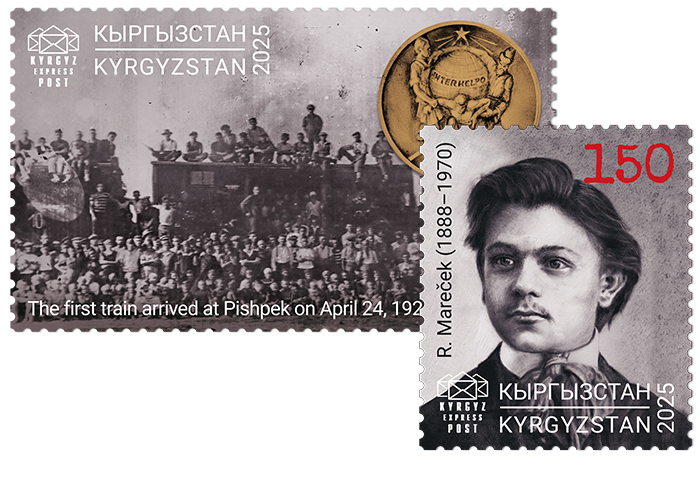
Interhelpo. Czechoslovak Industrial Cooperative, 100 years
Newsletter no. 115.pdf
On September 5, 2025 the Ministry of Digital Development and
Innovative Technologies of the Kyrgyz Republic puts into circulation a series of Kyrgyz Express Post postage
stamps: "Interhelpo. Czechoslovak Industrial Cooperative, 100 years".
In 2025, Kyrgyzstan celebrates a significant anniversary in its
history – the 100th anniversary of the "Interhelpo" cooperative. This cooperative made a significant
contribution to the industrial, social, and cultural development of Kyrgyz society.
The Interhelpo cooperative ("International Workers’ Aid,"
translated from the international language Ido) was founded in 1923 in Czechoslovakia, in the city of
Žilina. Its members were workers of various professions – builders, engineers, electricians, textile
workers, and artisans, as well as doctors and teachers. The group numbered about 1,070 people, including
their family members. In 1925, the first group of Interhelpo members arrived in the capital of Soviet
Kyrgyzstan at Pishpek station (now Bishkek).
A special role in the history of Interhelpo was played by Rudolf
Pavlovič Mareček (1888–1970), a Czechoslovak revolutionary, engineer, and organizer of socialist
construction in Central Asia. He was one of the key inspirers behind the resettlement of Czechoslovak
workers to Kyrgyzstan, actively participated in the construction of the first industrial facilities in the
city of Frunze, and initiated many infrastructure projects. Thanks to Mareček and his colleagues, brick,
textile, sewing, and furniture factories were established; the first water supply systems, roads, and power
lines were laid; and European-style schools, hospitals, and residential buildings were constructed. Many
buildings and industrial facilities constructed by Interhelpo members have been preserved in Bishkek to this
day. It is important to note that the Interhelpo cooperative also became a significant training ground for
skilled personnel for the young Kyrgyz Republic.
The history of Interhelpo ended in 1943, when the cooperative's
property was transferred to the state. However, the memory of this phenomenon and the selfless help of
hundreds of Czechs and Slovaks is still honored by the Kyrgyz people. The National Historical Museum holds
rare exhibits dedicated to the life and work of Interhelpo members, and descendants of some of them still
live in Bishkek and other cities of Kyrgyzstan. KEP is proud to note that the creation of this new stamp
issue was actively supported by Lada Mareček and Elvira Mareček – respectively the great-granddaughter and
granddaughter of the founder of Interhelpo – who currently reside in Bishkek. It was Elvira Mareček who
authored the portrait of Rudolf Mareček featured on the KEP stamp. She also redesigned the Interhelpo
emblem, originally created by Mareček himself, for its 100th anniversary. The updated emblem is also
depicted on the KEP stamps.
The issue is rich in historical details. The upper margin of the
miniature sheet features a photograph of Rudolf Mareček bidding farewell to the first transport at the
Žilina railway station (he was unable to travel with the first group to Kyrgyzstan for reasons beyond his
control). The first coupon on the right shows one of the earliest workshops, set up directly under the trees
shortly after arrival in Pishpek. The second coupon next to it depicts the first Fordson tractor brought by
the Interhelpo cooperative in 1925. The third and fourth coupons (lower left) feature the first sewing
workshop of Interhelpo and a commemorative plaque displayed in Bishkek.
KEP is confident that this new stamp issue will contribute to
celebrating the centenary of Interhelpo and to the development of friendship and fruitful cooperation
between the peoples of Kyrgyzstan, Czechia and Slovakia. We look forward to welcoming many visitors to the
famous “Sberatel 2025” Collector Fair in Prague, where they will be able to visit the KEP booth and see the
new issues.
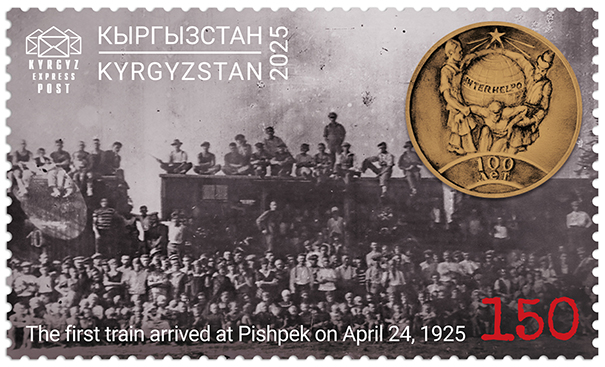
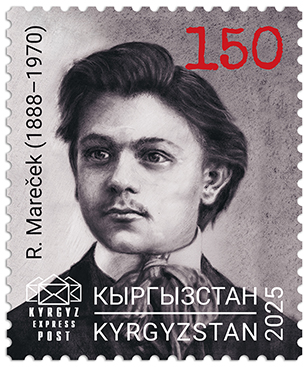
Stamps description
No. 257. 150 KGS. The first group of Interhelpo membersNo. 258. 150 KGS. Rudolf Pavlovič Mareček (1888–1970)
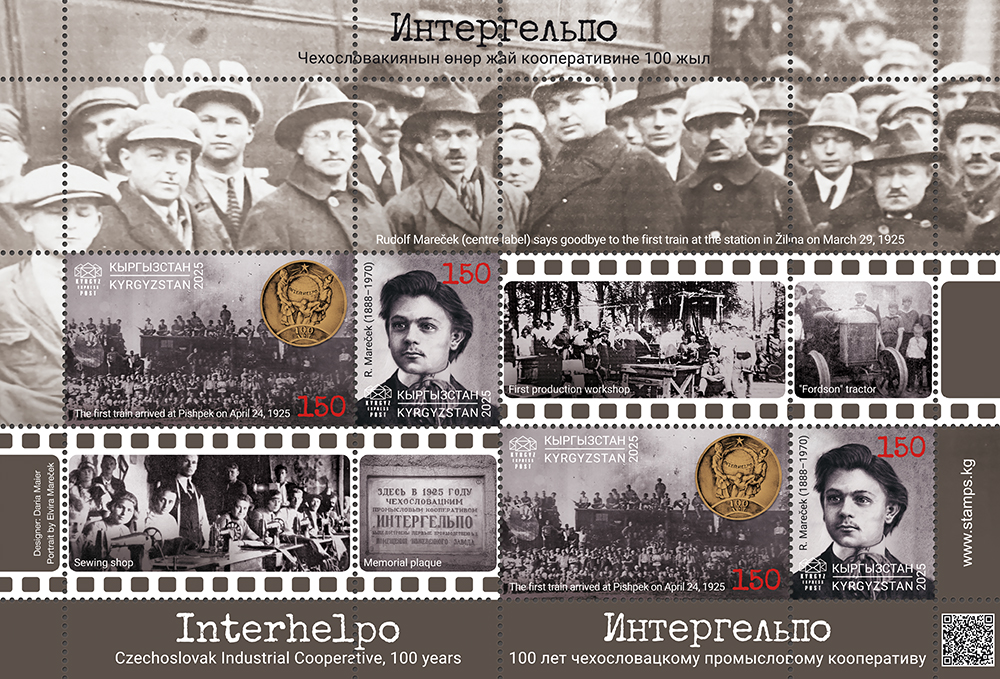
Technical specifications
Paper: coated, gummed, 105 g/m².
Printing method: full-color offset lithography.
Stamps perforation: comb 14:14½.
Stamps size: 46 × 27.5 mm. and 23 × 27.5 mm.
Stamps are issued in collective minisheets of 4 stamps (two complete sets and one 4 labels).
Collective minisheet size: 159 × 108 mm.
Quantity issued: 3 000 pieces each stamp (1 500 collective minisheets).
Artist: Elvira Mareček.
Designer: Daria Maier.
Printer House: "Nova Imprim" (Chișinău, Moldova).
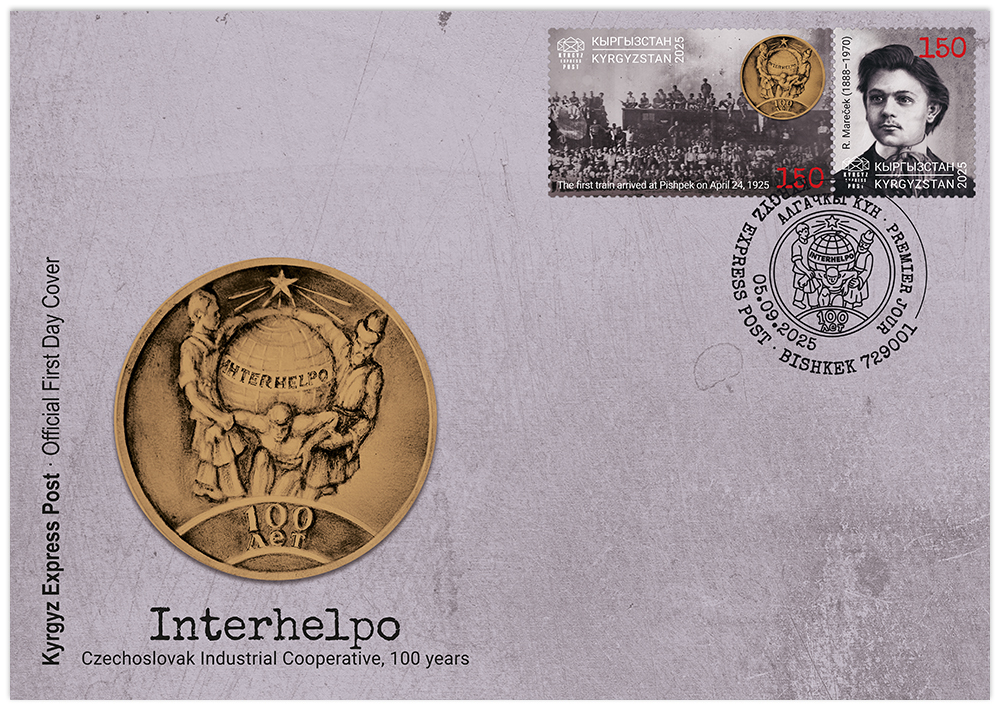
A special cancellation on FDC will be carried out at the Bishkek KEP Office (729001) on the stamps issuing day.
The first day cover, postcards and special
postmark are designed by Daria Maier.
Cover size: С6 (162 × 114 mm).
Quantity of covers issued: 300 pieces each.
Endorsing ink color: black.
Stamps and FDCs can be purchased here.



